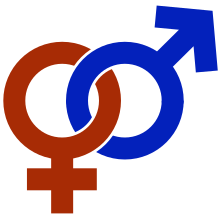
Back Gender Afrikaans Gender ALS ፆታ Amharic نوع اجتماعي Arabic Gender Azerbaijani Енсиәт Bashkir Lītės BAT-SMG Гендар Byelorussian Гендэр BE-X-OLD Джендър Bulgarian

Gender includes the social, psychological, cultural and behavioral aspects of being a man, woman, or other gender identity.[1][2] Depending on the context, this may include sex-based social structures (i.e. gender roles) and gender expression.[3][4][5] Most cultures use a gender binary, in which gender is divided into two categories, and people are considered part of one or the other (boys/men and girls/women);[6][7][8] those who are outside these groups may fall under the umbrella term non-binary. Some societies have specific genders besides "man" and "woman", such as the hijras of South Asia; these are often referred to as third genders (and fourth genders, etc.). Most scholars agree that gender is a central characteristic for social organization.[9]
In the mid-20th century, a terminological distinction in modern English (known as the sex and gender distinction) between biological sex and gender began to develop in the academic areas of psychology, sexology, and feminism.[10][11] Before the mid-20th century, it was uncommon to use the word gender to refer to anything but grammatical categories.[3][1] In the 1970s, feminist theory embraced the concept of a distinction between biological sex and the social construct of gender. The distinction between gender and sex is made by most contemporary social scientists in western countries,[12][13][14] behavioral scientists and biologists,[15] many legal systems and government bodies,[16] and intergovernmental agencies such as the WHO.[17]
The social sciences have a branch devoted to gender studies. Other sciences, such as psychology, sociology, sexology and neuroscience, are interested in the subject. The social sciences sometimes approach gender as a social construct, and gender studies particularly do, while research in the natural sciences investigates whether biological differences in females and males influence the development of gender in humans; both inform the debate about how far biological differences influence the formation of gender identity and gendered behavior. Biopsychosocial approaches to gender include biological, psychological, and social/cultural aspects.[18][19]
- ^ a b Haig, David (April 2004). "The Inexorable Rise of Gender and the Decline of Sex: Social Change in Academic Titles, 1945–2001" (PDF). Archives of Sexual Behavior. 33 (2): 87–96. CiteSeerX 10.1.1.359.9143. doi:10.1023/B:ASEB.0000014323.56281.0d. PMID 15146141. S2CID 7005542. Archived from the original (PDF) on 15 June 2012.
- ^ "What do we mean by "sex" and "gender"?". World Health Organization. Archived from the original on 30 January 2017. Retrieved 26 November 2015.
- ^ a b Udry, J. Richard (November 1994). "The Nature of Gender". Demography. 31 (4): 561–573. doi:10.2307/2061790. JSTOR 2061790. PMID 7890091. S2CID 38476067.
- ^ Lindqvist, Anna; Sendén, Marie Gustafsson; Renström, Emma A. (2 October 2021). "What is gender, anyway: a review of the options for operationalising gender". Psychology & Sexuality. 12 (4): 332–344. doi:10.1080/19419899.2020.1729844. S2CID 213397968.
- ^ National Academies of Sciences, Engineering, and Medicine (2022). Bates, Nancy; Chin, Marshall; Becker, Tara (eds.). Measuring Sex, Gender Identity, and Sexual Orientation. Washington, DC: The National Academies Press. doi:10.17226/26424. ISBN 978-0-309-27510-1. PMID 35286054. S2CID 247432505.
{{cite book}}: CS1 maint: multiple names: authors list (link) - ^ Sigelman, Carol K.; Rider, Elizabeth A. (2017). Life-Span Human Development. Cengage Learning. p. 385. ISBN 978-1-337-51606-8. Archived from the original on 4 August 2021. Retrieved 4 August 2021.
- ^ Maddux, James E.; Winstead, Barbara A. (2019). Psychopathology: Foundations for a Contemporary Understanding. Routledge. ISBN 978-0-429-64787-1. Archived from the original on 4 August 2021. Retrieved 4 August 2021.
- ^ Kevin L. Nadal, The Sage Encyclopedia of Psychology and Gender (2017, ISBN 1483384276), p. 401: "Most cultures currently construct their societies based on the understanding of gender binary—the two gender categorizations (male and female). Such societies divide their population based on biological sex assigned to individuals at birth to begin the process of gender socialization."
- ^ Heinemann, Isabel (2012). Inventing the Modern American Family: Family Values and Social Change in 20th Century United States. Campus Verlag. p. 36. ISBN 978-3-593-39640-8. Archived from the original on 27 August 2021. Retrieved 28 July 2021.
- ^ Hausman, Bernice (1995). Changing Sex: Transsexualism, Technology, and the Idea of Gender. United Kingdom: Duke University Press. p. 95. ISBN 0822316927.
- ^ Germon, J. (2009). "Money and the Production of Gender". Gender. New York: Palgrave Macmillan. pp. 23–62. doi:10.1057/9780230101814_2. ISBN 978-1-349-37508-0.
- ^ Kimmel, Michael S. (2017). The gendered society (Sixth ed.). New York. p. 3. ISBN 978-0-19-026031-6. OCLC 949553050.
{{cite book}}: CS1 maint: location missing publisher (link) - ^ Lindsey, Linda L. (2010). "Ch. 1. The Sociology of gender" (PDF). Gender Roles: A Sociological Perspective. Pearson. ISBN 978-0-13-244830-7. Archived from the original (PDF) on 5 April 2015.
- ^ Paludi, Michele Antoinette (2008). The Psychology of Women at Work: Challenges and Solutions for Our Female Workforce. ABC-CLIO. p. 153. ISBN 978-0-275-99677-2. Archived from the original on 20 October 2021. Retrieved 30 August 2021.
- ^ O'Halloran, Kerry (2020). Sexual orientation, gender identity and international human rights law: common law perspectives. London. pp. 22–28, 328–329. ISBN 978-0-429-44265-0. OCLC 1110674742.
{{cite book}}: CS1 maint: location missing publisher (link) - ^ "Gender: definitions". www.euro.who.int. Archived from the original on 25 September 2021. Retrieved 22 August 2021.
- ^ Iantaffi, Alex (2017). How to Understand Your Gender: A Practical Guide for Exploring Who You Are. Jessica Kingsley Publishers. ISBN 978-1785927461.
- ^ Knudson-Martin, Carmen; Mahoney, Anne Rankin (March 2009). "Introduction to the Special Section-Gendered Power in Cultural Contexts: Capturing the Lived Experience of Couples". Family Process. 48 (1): 5–8. doi:10.1111/j.1545-5300.2009.01263.x. PMID 19378641.
© MMXXIII Rich X Search. We shall prevail. All rights reserved. Rich X Search